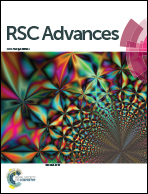Can a gas phase contact ion pair containing a hydrocarbon carbocation be formed in the ground state?†
Abstract
So far, no conclusive evidence of a ground-state contact ion-pair containing a hydrocarbon carbocation has been given in the gas phase. Due to the very high stability of the 1,2:4,5-dibenzotropylium (or dibenzo[a,d]tropylium) carbocation, we suggest (supported by DFT and MP2 calculations) the formation of a contact ion pair between this carbocation and chloride, occurring during the reaction between 1,2:4,5-dibenzotropyl (also named dibenzo[a,d]tropyl or dibenzo[a,d]cycloheptenyl) radical and chlorine atom at very low temperatures, through the harpoon mechanism. This is the first modeling study to find computational evidence for the possibility of a gas-phase contact ion pair (containing a hydrocarbon carbocation) formed in the ground state. Identification of this metastable species can be carried out by trapping it in He nanodroplets, along with infrared laser spectroscopy routinely coupled with this technique.



 Please wait while we load your content...
Please wait while we load your content...